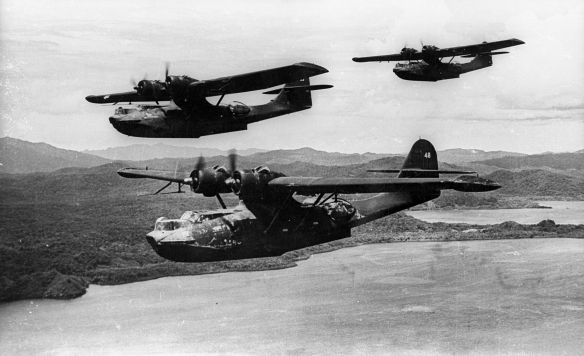Several squadrons of PBY-5As and -6As in the Pacific theater were specially modified to operate as night convoy raiders. Outfitted with state-of-the-art magnetic anomaly detection gear and painted flat black, these “Black Cats” attacked Japanese supply convoys at night. Catalinas were surprisingly successful in this highly unorthodox role. Between August 1943 and January 1944, Black Cat squadrons sank 112,700 tons of merchant shipping, damaged 47,000 tons, and damaged 10 Japanese warships.
The Royal Australian Air Force (RAAF) also operated Catalinas as night raiders, with four squadrons Nos. 11, 20, 42, and 43 mounting mine-laying operations from 23 April 1943 until July 1945 in the southwest Pacific deep into Japanese-held waters, that bottled up ports and shipping routes and kept ships in the deeper waters to become targets for US submarines; they tied up the major strategic ports such as Balikpapan that shipped 80% of Japanese oil supplies. In late 1944, their precision mining missions sometimes exceeded 20 hours in duration and were carried out from as low as 200 feet in the hours of darkness. Operations included the bottling up the Japanese fleet in Manila Bay planned to assist General MacArthur’s landing at Mindoro in the Philippines. Australian Catalinas also operated out of Jinamoc in Leyte Gulf, and mined ports on the Chinese coast from Hong Kong as far north as Wenchow. They were the only non-American bomber squadrons operating north of Morotai in 1945. The RAAF Catalinas regularly mounted nuisance night bombing raids on Japanese bases, earning the informal title “The First and the Furthest”. Targets of these raids included the major base at Rabaul. RAAF aircrews, like their US Navy counterparts, employed ‘terror bombs’, ranging from mere machine gunned scrap metal and rocks to empty beer bottles with razor blades inserted into the necks, to produce high pitched screams as they fell, keeping Japanese soldiers awake and scrambling for cover.
